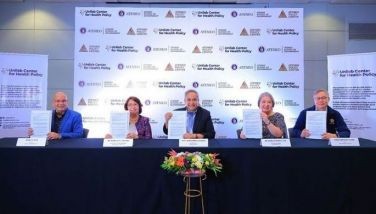Treat the tariff war with urgency, please

I was rather disappointed at the reaction of Marcos’ economic team following President Trump’s “Liberation Day” announcement. The Philippines was slapped a 17 percent tariff for exports to the US.
At a press briefing, DTI Secretary Cristina Roque said that the country will be less impacted by the tariffs since our rate is lower than most of our neighbors. Roque’s comment belittles the situation. Whether the impact is minimal or substantial, the DTI should be preparing contingencies and/or finding ways to use the situation to our advantage. It is not business as usual.
Roque also suggested that the Philippines actively engage the US to discuss a Free Trade Agreement (FTA). This suggestion seems tone-deaf to me, considering the US, under Trump, no longer honors trade agreements.
For his part, Investment and Economic Affairs Secretary Frederick Go was quoted as saying, “To me it looks like good news… I compared 10 countries, does it (referring to the Philippine tariff rate) look bad to you? Looks good, right?” Secretary Go is evidently unperturbed.
Roque and Go are missing the point. In their minds, the fact that the Philippines was slapped the second lowest tariff rate is a positive development. As Secretary Go said, it opens the opportunity for manufacturers based in countries levied with higher tariffs to relocate to the Philippines. While valid, it is a shallow view of the situation. Fact is, Trump’s Liberation Day announcement effectively changed the world order in terms of trade and many aspects of diplomacy. It is a seismic shift from the status quo and government cannot afford to be cavalier about it.
For decades, America was the bedrock of trade liberalization. It promoted free trade and globalization under a rules-based system governed by the World Trade Organization. Free trade allowed many countries to prosper, including the Philippines.
Trump’s announcement upended this system. We now operate under an environment of intense protectionism, where countries act not based on bilateral or multilateral interest but on their sole benefit; and where “might makes right” and bullying smaller nations for better trade deals is the norm.
The implications on the Philippines are enormous. First, Trump’s tariffs will weigh heavily on the global economy. It will most certainly result to slower global growth and a worldwide slump in trade and investments. This comes at a time when the Philippines is rallying to become a trillion-dollar economy by 2033 and a high income economy by 2050. Our path to prosperity will be disrupted if we fail to shift policies appropriately. The fact that our economic managers do not seem worried is a cause for concern.
Second, one may argue that the Philippines is safe since service exports like those from IT-BPOs are exempt from tariffs. The same for semi-conductors. But like I said, trade and investments will plummet. We will still be impacted with an overall decline in export revenues and less foreign direct investments. How will government compensate for this?
Third, the US is the Philippines’ largest export market, taking up 15.7 percent of Philippine exports worth $11.55 billion (in 2023). Every export dollar counts since our base is small. US tariffs will negatively impact our export incomes and will worsen our already worrisome trade deficit. What is government’s contingency?
Fourth, America has begun to look inward and many countries are bound to follow. America frowns at immigrants and so will others. It will only be a matter of time before we feel the blowback on OFW remittances. What then?
Fifth, again, one may argue that ours is a consumer-led economy so we are relatively insulated from shocks in world trade. Not true. If our exports, investments and OFW remittances decline, we can say goodbye to the cashflow that makes our consumer-led economy tick. Government’s spending cannot carry the load alone. Does government have a plan for this eventuality?
Sixth, what if other countries follow America’s example (and many will) of bullying smaller economies like the Philippines into one-sided trade deals? Is government actively strengthening our trade leverages? We will be a sitting duck otherwise.
Seventh, the Philippines is a two-trick pony in as far as international trade is concerned. We principally earn from IT-BPOs and electronics assembly. That’s it. The IT-BPO industry is threatened by artificial intelligence. Electronics assembly is threatened by competition from nations with more hospitable business environments. And now, both industries are threatened by tariffs and protectionism. Neither the Duterte nor Marcos administration have developed a new industry for which the country can depend on for revenues. This should worry us all and we should hold our leaders accountable for failing to do so. What now?
Eighth, America has proven to be unstable in its commitments in both trade and defense. In light of China’s increasing aggression and illegal grab of the West Philippine Sea, it is only prudent that the Philippine government commits more resources towards achieving a higher level of defense autonomy. Twenty F-16 fighter jets and the Typhon Missile System is not enough. Which leads to my question – have our political leaders, starting with Malacañang and Congress, done the correct and patriotic act of sacrificing their pork barrel funds to increase defense spending?
History has a way of repeating itself. The Smoot-Hawley Tariff Act of 1930 triggered a decade-long economic depression. This gave rise to fascism, which in turn led to World War 2. Is the Philippines ready to defend itself in a time of war?
Perhaps the entire breadth of implications has not sunk in on Marcos’ team yet. They better wake up since there is no time to relax. A new world order is upon us and we will do well to plan forward and do so with urgency. I hope for more circumspection and urgent action from Marcos’ team.
* * *
Email: andrew_rs6@yahoo.com. Follow him on Twitter @aj_masigan
- Latest
- Trending


























